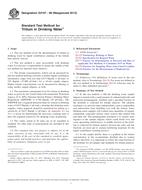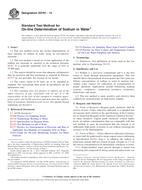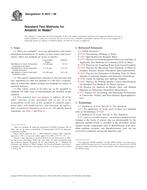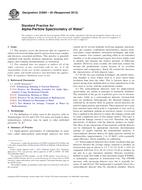Potřebujeme váš souhlas k využití jednotlivých dat, aby se vám mimo jiné mohly ukazovat informace týkající se vašich zájmů. Souhlas udělíte kliknutím na tlačítko „OK“.
ASTM D4107-08(2013)
Standard Test Method for Tritium in Drinking Water
Automaticky přeložený název:
Standardní zkušební metoda pro tritium v pitné vodě
NORMA vydána dne 15.6.2013
Informace o normě:
Označení normy: ASTM D4107-08(2013)
Poznámka: NEPLATNÁ
Datum vydání normy: 15.6.2013
Kód zboží: NS-26066
Počet stran: 6
Přibližná hmotnost: 18 g (0.04 liber)
Země: Americká technická norma
Kategorie: Technické normy ASTM
Kategorie - podobné normy:
Anotace textu normy ASTM D4107-08(2013) :
Keywords:
drinking water, 3H, liquid scintillation, radioactivity, radioisotope, tritium, ICS Number Code 13.060.50 (Examination of water for chemical substances)
Doplňující informace
| Significance and Use | ||||||||||
|
5.1 This test method was developed for measuring tritium in water to determine if the concentration exceeds the regulatory statutes of drinking water. This test method also is applicable for the determination of tritium concentration in water as required by technical specifications governing the operations of nuclear power facilities. With suitable counting technique, sample size, and counting time a detection limit of less than 37 Bq/L (1000 pCi/L) is attainable by liquid scintillation. |
||||||||||
| 1. Scope | ||||||||||
|
1.1 This test method covers the determination of tritium in drinking water by liquid scintillation counting of the tritium beta particle activity. 1.2 This test method is used successfully with drinking water. It is the user's responsibility to ensure the validity of this test method for untested water matrices. 1.3 The tritium concentrations, which can be measured by this test method utilizing currently available liquid scintillation instruments, range from less than 0.037 Bq/mL (1 pCi/mL) to 555 Bq/mL (15 000 pCi/mL) for a 10-mL sample aliquot. Higher tritium concentrations can be measured by diluting or using smaller sample aliquots, or both. 1.4 The maximum contaminant level for tritium in drinking water as given by the United States Environmental Protection Agency (U.S. EPA) National Interim Primary Drinking Water Regulations (NIPDWR) is 0.740 Bq/mL (20 pCi/mL). The NIPDWR lists a required detection limit for tritium in drinking water of 0.037 Bq/mL (1 pCi/mL), meaning that drinking water supplies, where required, should be monitored for tritium at a sensitivity of 0.037 Bq/mL (1 pCi/mL). In Appendix X1, Eq X1.3 is given for determining the necessary counting time to meet the required sensitivity for drinking water monitoring. 1.5 The values stated in SI units are to be regarded as standard. No other units of measurement are included in this standard. 1.6 This standard does not purport to address all of the safety concerns, if any, associated with its use. It is the responsibility of the user of this standard to establish appropriate safety and health practices and determine the applicability of regulatory limitations prior to use. |
||||||||||
| 2. Referenced Documents | ||||||||||
|
Podobné normy:
Historická
1.1.2013
Historická
1.5.2011
Historická
1.10.2008
Historická
15.5.2009
Historická
1.6.2012
Historická
1.9.2012
Odebírejte informace o nově vydaných normách ZDARMA:
Chcete pravidelně odebírat informace o nově vycházejících normách z celého světa a to zcela zdarma?
Přihlašte se k odběru. Vše je velice jednoduché a absolutně ZDARMA.
Na výběr máte vydavatele z celého světa.



 ASTM D2791-13
ASTM D2791-13 ASTM D2908-91(2011)..
ASTM D2908-91(2011).. ASTM D2972-08
ASTM D2972-08 ASTM D3082-09
ASTM D3082-09 ASTM D3084-05(2012)..
ASTM D3084-05(2012).. ASTM D3223-12
ASTM D3223-12
 Cookies
Cookies
